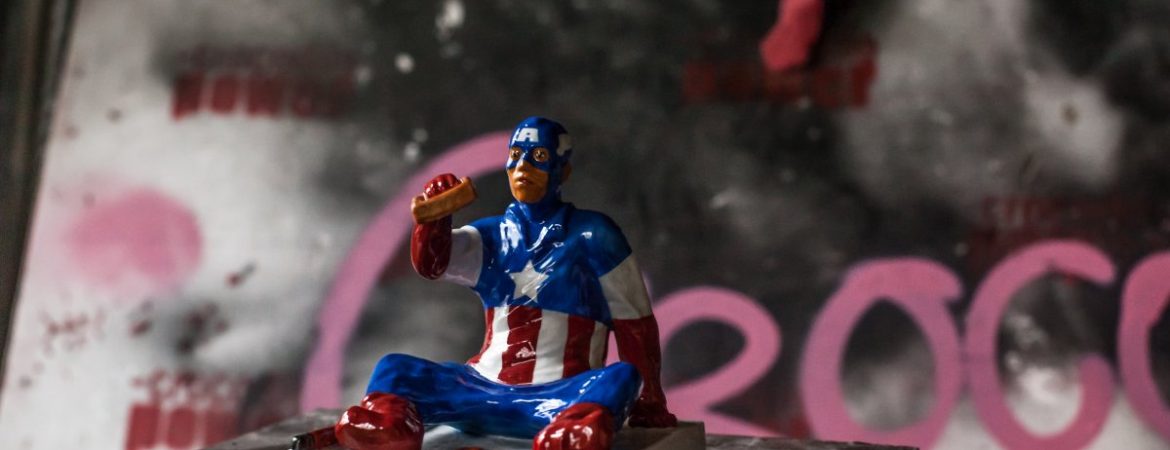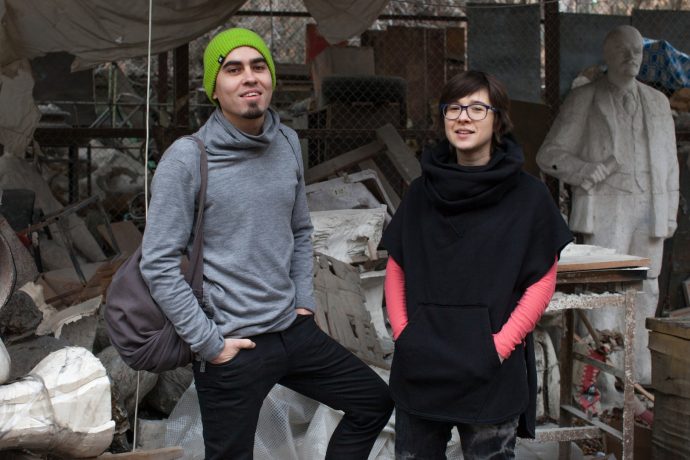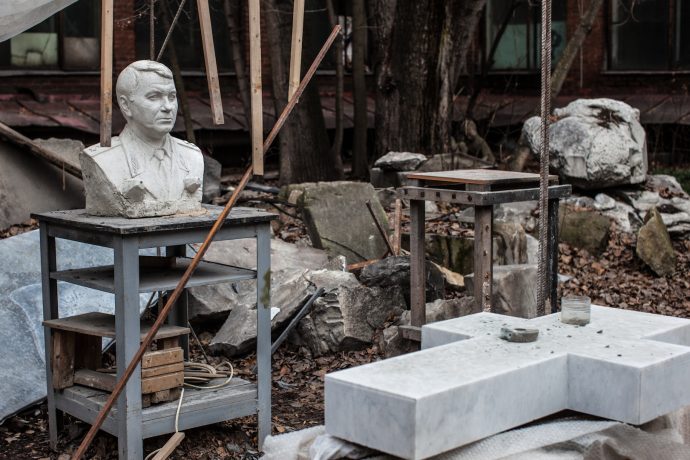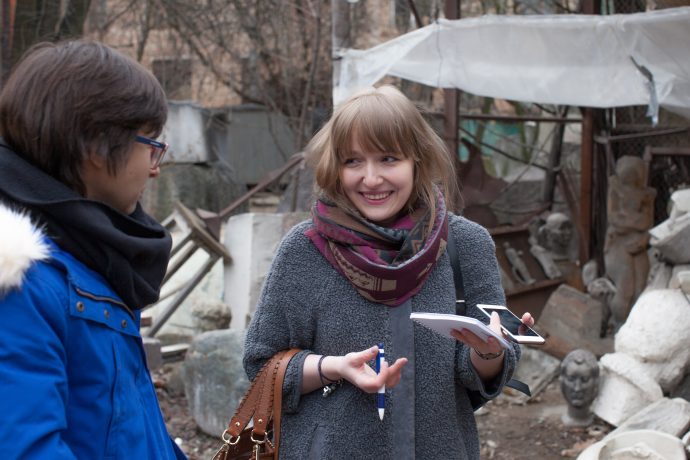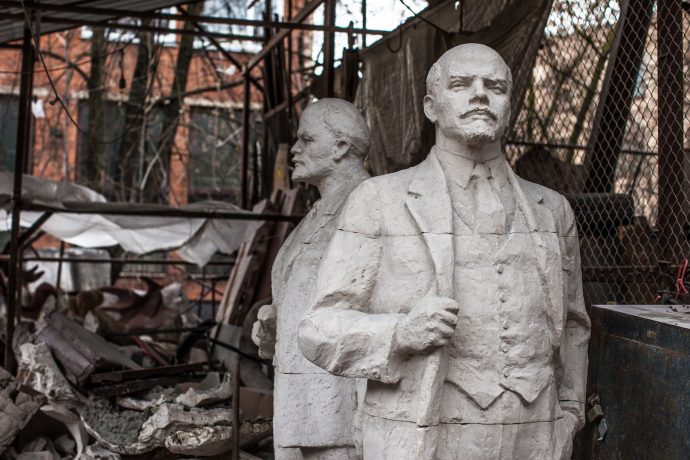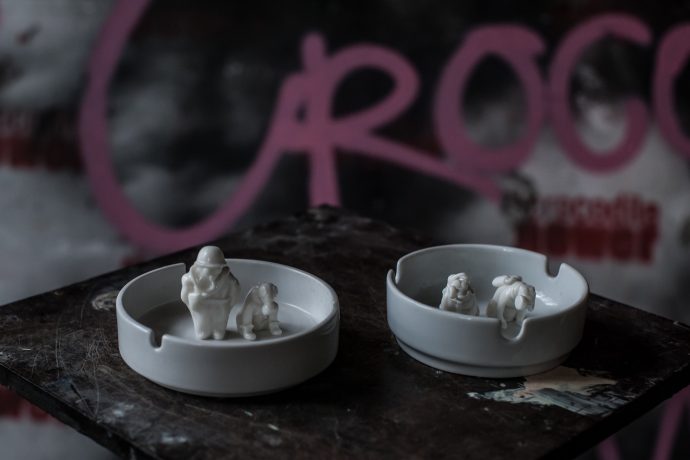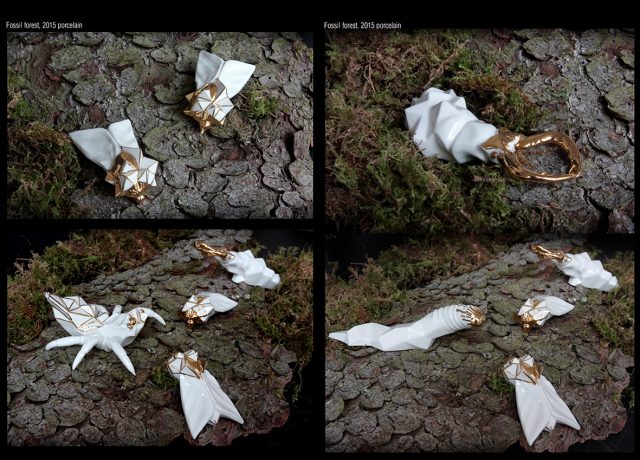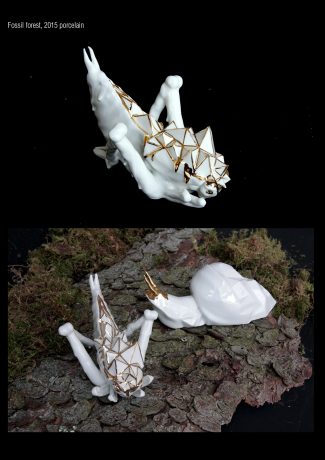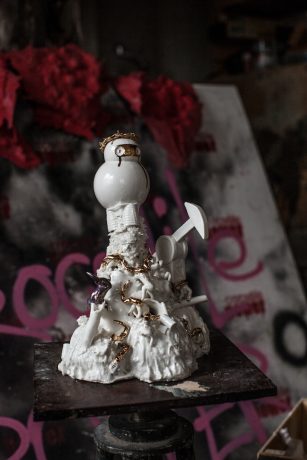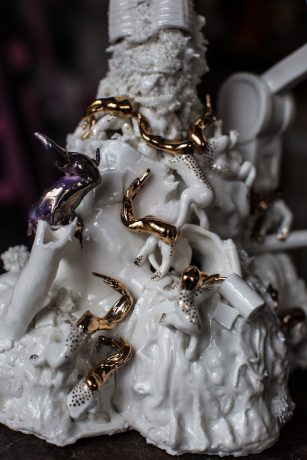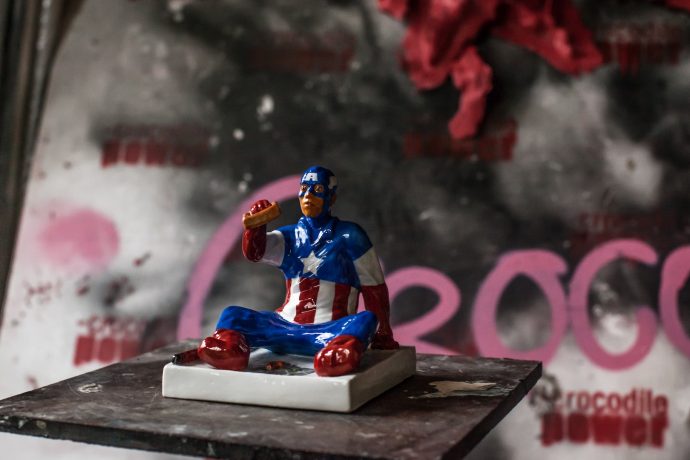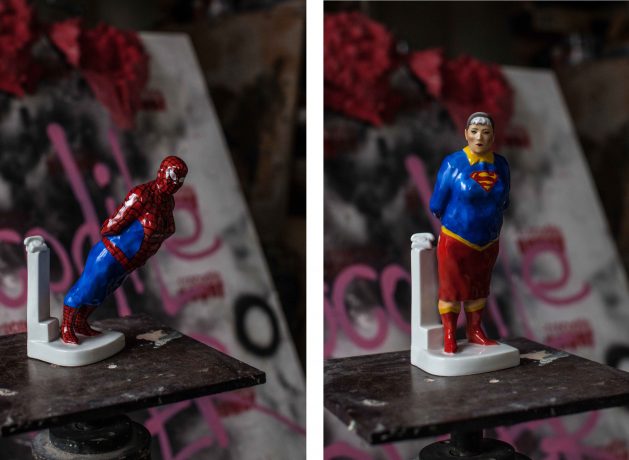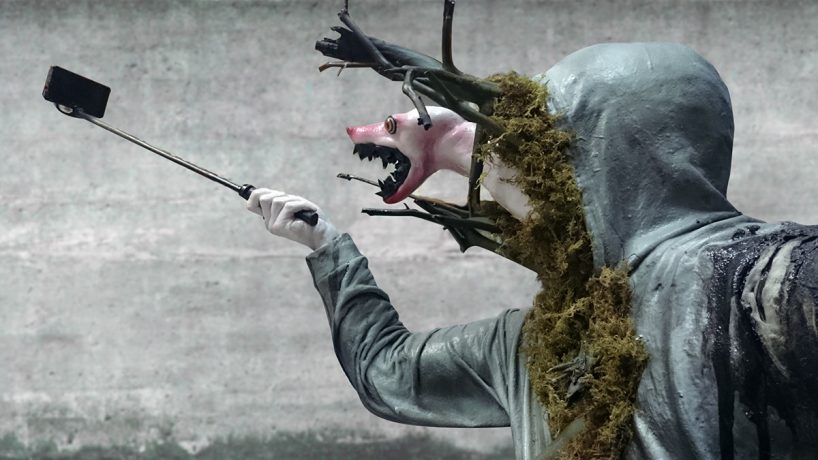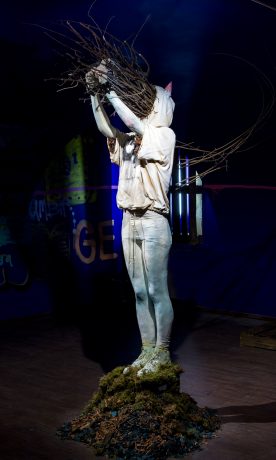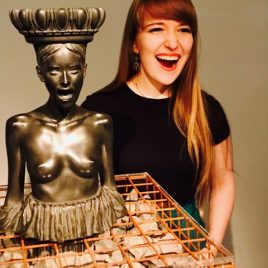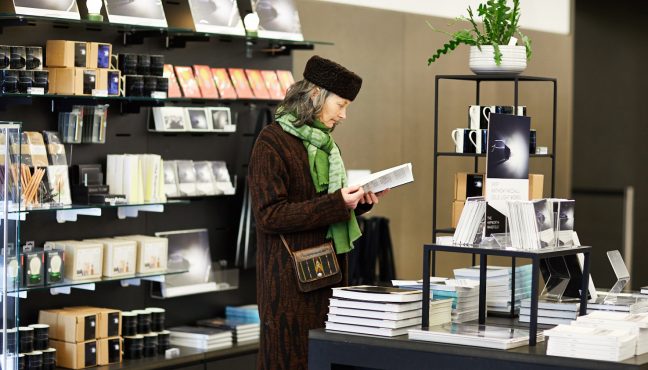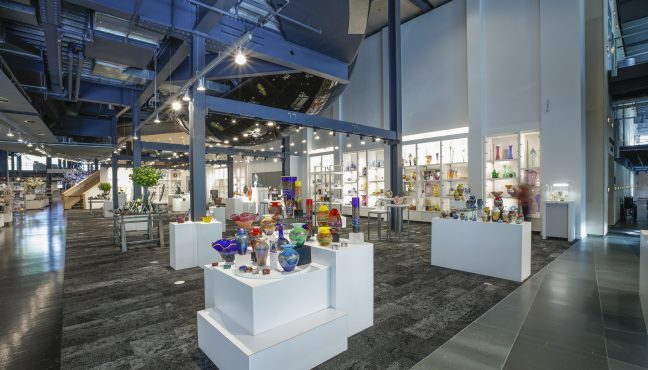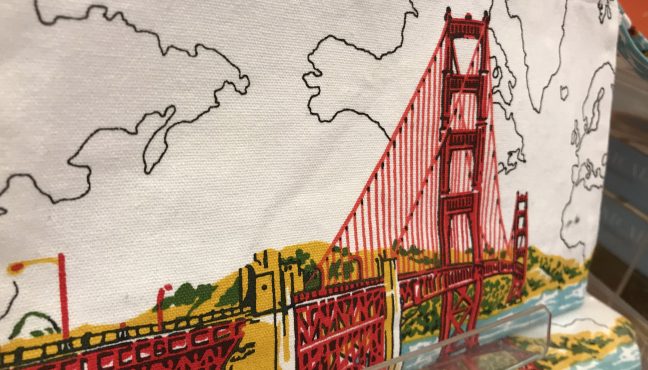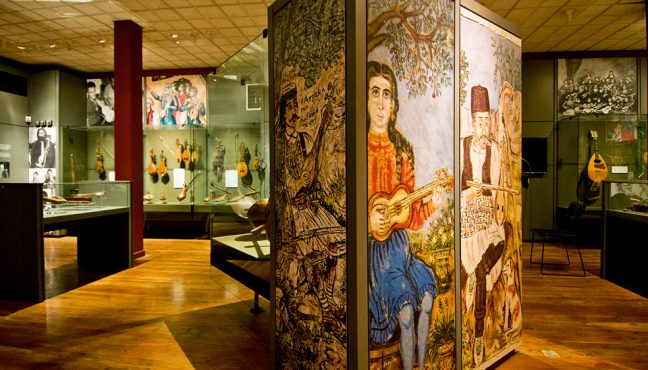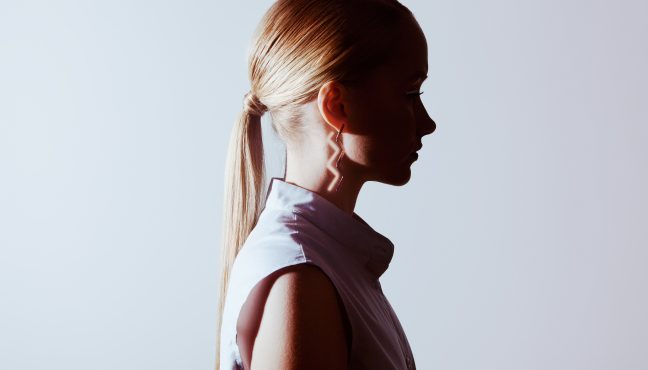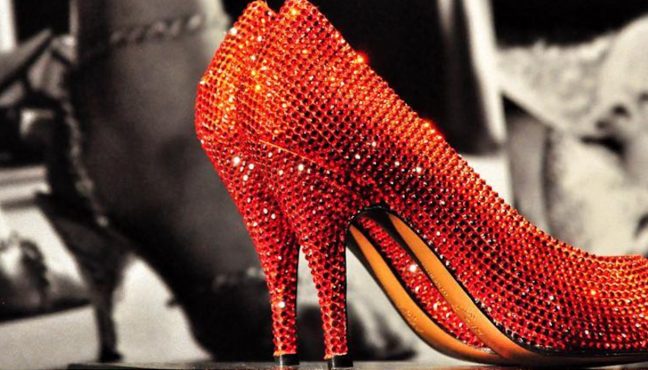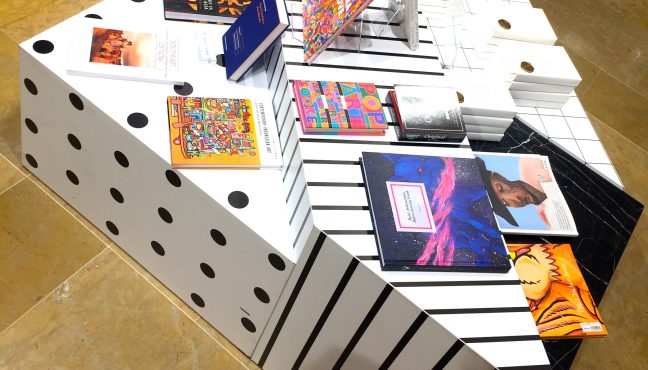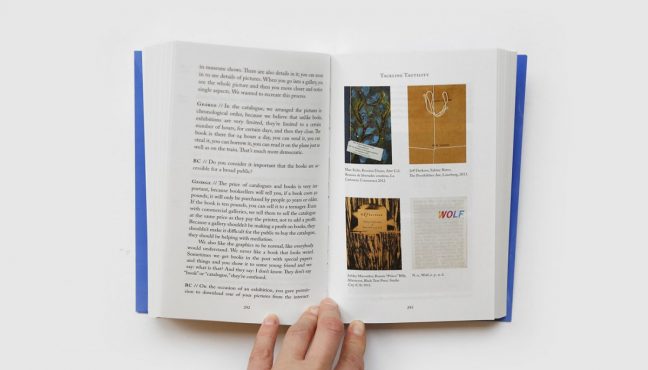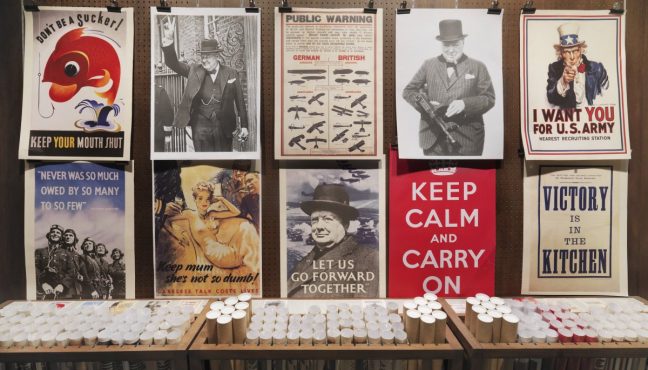When the holiday season was still on its way, we at the Museeum decided to buy artistic gifts. Museeum authors from France, Japan, UK and US found excellent presents made by local contemporary artists in museums or online, but here in Russia we just hit a wall! It all went down to this: pay a Sothbey’s price or buy a mass-market product. It was especially sad, since we set our hearts on works by a Russian art-group CrocodilePOWER that we’ve seen at the 23rd International Biennale of Vallauris (France). We visited the delightful CrocodilePOWER duo – Peter Goloshchapov and Oxana Simatovain at their Moscow studio to find out, if we could buy their small works and ended up talking about pride, prejudice and challenges artists face in Russia.
First of all, it is impossible not to mention that this “post-apocalyptic” scenery by your studio is somewhat inspiring and even makes you think of some of your works. For example “Twilight of resource”… By the way, works from the series could be found and bought at Vallauris Biennale, right?
Peter: We presented 3 projects at Vallauris – “Everyman” at the international pavilion, “Twilight of resource” and “Fossil forest” in the Russian pavilion. Our “forest” had many bugs and other small objects, at first we didn’t plan to sell them separately, but after the Biennale we created a few more bugs and decided to offer them to various shops.
Oxana: We didn’t want to sell our works ourselves, we wanted everything, including the sales, to be professional. Ideally there should be a manager, who can take care of sales.
Peter: I think this will happen, when we’ll have a picture-perfect studio with a leather sofa. I dream of renovating our workshop and I can already see myself on that sofa, holding a meeting. I don’t know what I’ll talk about, but that picture is amusing. For now our studio reminds a warehouse, especially now – when we hold a solo exhibition “Out of Range” in the Moscow Museum of Modern Art and take part in a group exhibition “Hurrah! Sculpture” at Winzavod Center for Contemporary Art in Moscow.
But the warehouse studio is charming in its own way! This place has its spirit. The whole building is very interesting – a real cooperative society, a partnership, where artists have their own studios and sometimes share them.
Oxana: The courtyard also has its own spirit and its own mind – it consumed one of our works. After our solo exhibition “Inner Taiga” in the Triumph Gallery the works came back to our studio, but we couldn’t fit them in. So we left one in this very courtyard and we didn’t know that it was just before the cleanup day, so our work vanished.
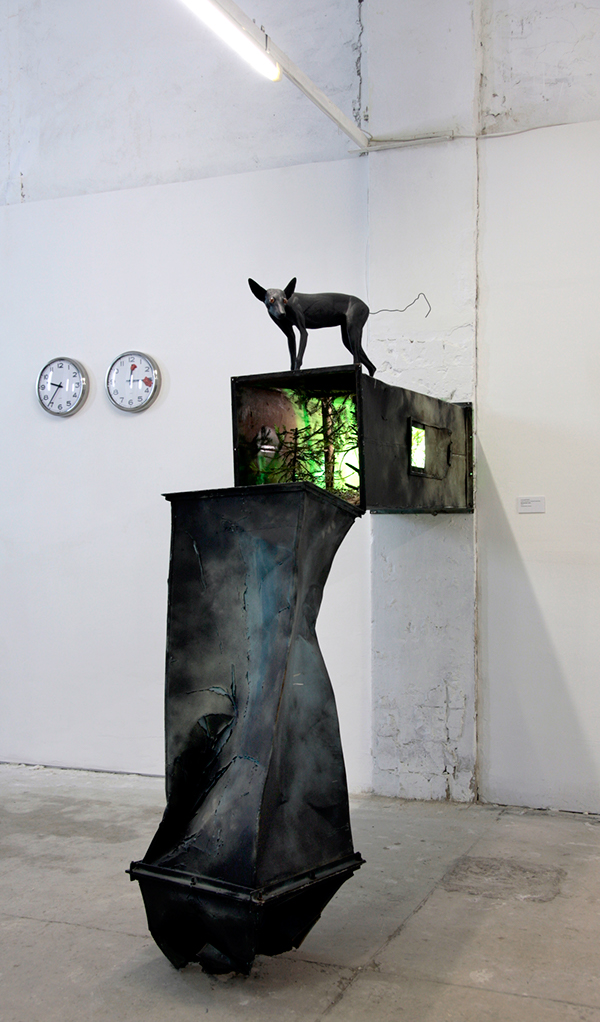
It is especially sad, since there are so many plaster parts, Lenin parts, stones and things from the past century, that obviously won’t be reclaimed, but they are still here. Just a thought – maybe it would not have been so upsetting if there were small porcelain copies of the object sold?
Peter: If it’s a porcelain work, it’s not that easy. Let me explain – our skills allow us to complete the whole operating cycle by ourselves.
Oxana:The whole cycle, but not sales.
Peter: Yes, exactly, starting from the idea to its implementation – everything is made by us. We create forms, molds, we make saggars, serrated saddles, we do the firing in our own kiln, and we glaze the wares. So each piece is purely hand-made exclusively by this very set of 4 hands. We can make 3-4 molds, but they still won’t be the same.
Oxana: Our works are studio works, not factory works, we never thought of going industrial for commercial sales. And when we create a larger object, it is creativity “on-the-go”.
Peter: Our kiln is not that huge, so we literally form our works as if we were drawing a cartoon. Of course we have everything planned, but it is pure work in progress. You see that you need something else to convey your message, so you add it, but stick to the idea. First plan and then improvise. I bough this kiln, when I won the people’s choice at Kandinsky Prize in 2007. All of my friends were saying that a “sane man” would buy a car, but here we are with a kiln.
But it is great that you are not dependent on anyone to fire your works.
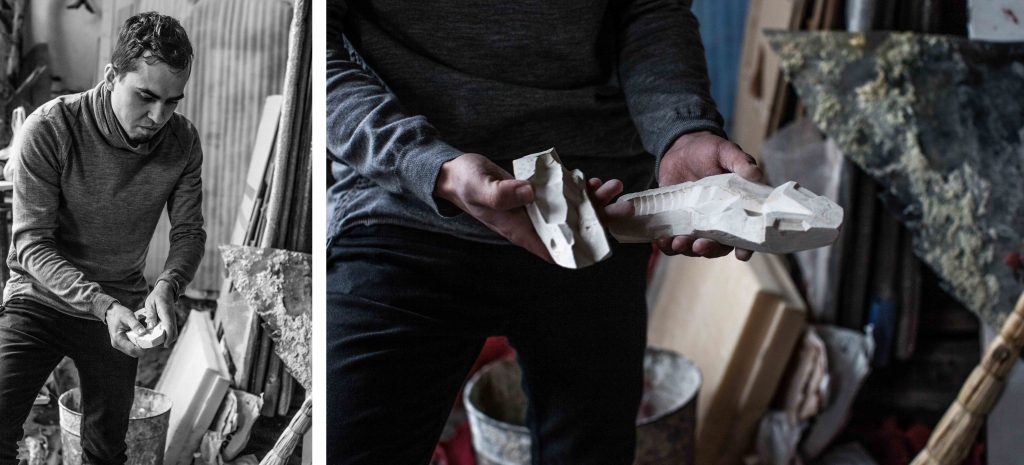
Oxana: Absolutely, especially since outstanding projects require outstanding investments. For artists it is always a problem, particularly here in Russia.
Peter: It brings us back to your first question about buying our small works. Russian art-society will not support you if you sell your works in shops. You will be forced out, labeled a cheesy pop commercial artist.
Oxana: In the modern world it is acceptable and favorable if you can sell your art by yourself without producers, without outside interference. But here the attitude is high-browed. Looking at Lenin’s dissolving statue, we can say that it is still difficult for our society to make friends with free market economy. Everyone feels embarrassed to sell. For example, if we had small porcelain works in MMOMA shop during our exhibition, we would hear: “they are rotten, commercial non-artists”. But we personally do not see it in this light. We want our objects to be available to a wider audience in a nice museum shop or an online store.
It is depressing that if feels like you have to apologize to someone for selling your own works.
Peter: And this is how it is. It is tolerable when an artist teaches classes, writes books, it is honorable if he works at a factory, or drives a bus, but it is unacceptable if he makes money off his art. The idea that a great artist must be poor and hungry penetrated the minds in the Soviet era and is still here.
Oxana: It is even more difficult since there is basically no art market in Russia. It is only making baby-steps now.
Peter: If we look at museums, there are just two world-class museum shops in Russia – Garage Museum of Contemporary Art and Jewish Museum and Tolerance Center. Recently we visited Garage and were very happy to see a project with a Russian brand Mineral Weather. They specially designed jewelry for Louise Bourgeois’ exhibition and their works are available only in Garage bookshop. We need more projects like that. Museums can lead the way and allow talented artists to sell their works.
Oxana: It would be great if Garage and other museums could hold tenders for artists, who can create exclusive objects for their bookshops. Museums all over the world can do that and bring talents into the light! It is difficult to leave Tate Modern or Washington National Art Gallery shops without buying something and there you can find great artworks, not only souvenirs.
Peter: There was one tender we took part in – “Russian souvenir”, it had to do with cosmos. We made uncommon souvenirs, funny, touching and unusual, but in the end, the winners were friends of the organizers with the old school, cliché pieces.
All-too-common, sad, but true!
Peter: But even sad stories get you somewhere. A few years after that tender we had our solo exhibition “Russian Space”. Here you can see the cosmonauts – astronauts story.
Oxana: Kids cosmonauts, who are building something out of shattered pieces of our past.
Peter: They want to launch a rocket, but the meaning, the purpose of their feverish activity is long gone. They build rockets, they live in them, but they are doomed to stay where they are.
Oxana: Parents of these kids are gone and these astronauts will never be able to fly into space, but they continue to play this game.
Peter: Again coming back to number of copies. It is almost impossible to make a copy of this work, since every hand, every man, and every piece was fired separately and then put together. The unique nature of porcelain forces you to work non-stop until you are done.This work took 2 full days to complete (including nighttime), we worked 48 hours because when the porcelain is dry you cannot add anything.
Oxana: We made a few small space stories for sale, but we didn’t find a shop, so we gave them away to our close friends.
Peter: Each of our works has a story. It all begins with a story, as I’ve said – creating a porcelain object is like drawing a cartoon – you have a plan, but sometimes you add something to make it even livelier.
What is your favorite creation?
Oxana: The one that we are working on now! I think it is always like that for me.
Peter: One of my favorites is from “Atomic Point” series. Here you can see squids fighting for their life, while this airship is poisoning them with crop dust. But the thing here is that this fight is between squids themselves: squids that had chosen evolutionary trajectory of development operate the airship. They didn’t stay on the ground and now they are advanced, so the fight is within. This is a battle with yourself, with an opponent within your mind that every person has to fight. Actually “Atomic Point” is one of my favorites also because it was a transition to a new level for us. We don’t stop we always move forward, we try to work using new techniques and new materials. For example fiberglass is our second-favorite after porcelain. It allows you to be more creative we are still uncovering its capabilities.
Oxana: But we also use techniques of the XVI century! French artist Bernard Palissy used to collect live frogs, snakes and insects, glaze them and fire in a kiln. The animals burned out, while the objects came out delicate, subtle and he didn’t have to sculpt anything. We are not that cruel though, we only use burs or other plants.
Peter: Yes, we have a strategic stockpile of moss and bark.
That sounds amazing! Strategic stockpile of moss, but wait, if you don’t glaze and fire it, it will rotten, wouldn’t it?
Oxana: If you don’t put moss under the sun it can be kept for years if not decades. In 2013 we made a plaster sculpture for MMOMA and used some moss that was essential to the work. They wanted to buy the sculpture, but said something about material being not sustainable. We thought they meant plaster, but it appeared they had reservations about moss!
Peter: We always work disregarding limitations, with no boundaries. If we want to create something, symbolizing that every man can be super man if he only wants to, we do it. Even though when we started with “Everyman” we encountered a real challenge. Our super women inclined forward and in the kiln their breast outweigh the back, so when we took them out they just jackknifed, but we found a way to make it right.
Oxana: We want to create without the kiln authorship!
Peter: Professionalism is to create something exactly as you intended it to be. And success is when you can create without looking back or glancing sideways. We do not confine ourselves in certain materials or themes. We work in different dimensions, with various forms. As of now we create sculptures, but it doesn’t mean that we won’t go back to small pieces soon. It feels like now large sculptures are getting attention all over the world, it is an energetic medium. So for now we are looking for new ways to express our ideas in this form.
We at the Museeum hope that crocodilePOWER will create more great large pieces and smaller ones for a larger audience! And we can’t wait to buy their items in museum shops all over the world!
